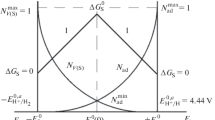Abstract
The repulsive force between two solid surfaces immersed in electrolyte solution is created by overlapping of the electrical double layers adjacent to the solid surfaces when the separation is large enough so that solvation forces can be neglected. When the repulsive force is known, one can calculate the Sternpotential at the solid surfaces. The repulsive interactions in electrolyte solutions were directly measured between two high-grade polished fused silica plates, one planar, the other spherically curved. The surfaces were covered with thin gold or chromium layers and separated by aqueous and alcoholic solutions of NH4Cl, NH4Br and NH4SCN in concentrations 10−5–10−2 M. The absolute value of the negative Stern potential derived from the repulsive forces increased when regarding the anions in the order
in parallel to the strength of specific adsorption.
Similar content being viewed by others
References
Gouy G (1917) Ann Physique 7:129
Chapman DL (1913) Phil Mag 25:475
Verwey EJW, Overbeek JThG (1948) Theory of the stability of lyophobic colloids. Elsevier, Amsterdam
Sonntag H (1977) Lehrbuch der Kolloidwissenschaft VEB, Deutscher Verlag der Wissenschaften, Berlin
Stern O (1924) Z Electrochem 30:508
Lyklema J (1977) J Colloid Interf Sci 58:242
Grahame DC (1947) Chem Rev 41:441
Hunter RJ (1981) Zeta potential in colloid science principle and applications. Academic Press, London, New York, Toronto, Sydney, San Francisco
Bockris JO'M, Reddy AKN (1970) Modern electrochemistry, Vol. 2. Plenum Press, New York
Andersen TN, Bockris JO'M (1964) 9:347
Trasatti S (1975) J Electroanal Chem 65:815
Habib MA, Bockris JO'M (1980) In: Bockris JO'M, Conway BE, Yeager E (eds) Comprehensive treatise of electrochemistry, Vol 2. Plenum Press, pp 135–219
Lorenz W, Sahe G (1961) Z Phys Chem Leipzig 218:259
Schultze JW, Vetter KJ (1973) J Electroanal Chem 44:63
Muller VM, Martynov GA, Kuzmina GL, Bulatova V (1976) Kolloidn Zh 38:480
Muller VM (1974) In: Surface forces in thin films and the stability of colloids(in Russian). Jzd Nauka, Moskow, p 254
Peschel G, Belouschek P (1976) Progr Colloid Polym Sci 60:108
Peschel G, Belouschek P (1977) Z Phys Chem Neue Folge 108:145
Peschel G, Belouschek P, Müller MM, Müller MR, König R (1982) Colloid Polym Sci 260:444
Peschel G, Keldenich J (1987) Ber Bunsenges Phys Chem 91:285
Lorenz D, private communication
Keldenich J (1987) Dissertation, University of Essen FRG
Israelachvili JN, Adams GE (1978) J Chem Soc Faraday Trans 1 74:975
Pashley RM (1981) J Colloid Interf Sci 80:153, 83:531
Sebba F (1962) Ion flotation. Elsevier, Amsterdam, London, New York
Karger BL, Pinfold TA, Palmer SH (1970) Separation Sci 5:603
Lemlich R (1972) Adsorptive bubble separation techniques. Academic Press, New York, London
Usyarov OG (1975) Kolloidn Zh 37:79
Frumkin A, Poyanovskaya N, Grigoryev N (1965) Electrochim Acta 10:793
Damaskin BB, Frumkin A (1974) Electrochim Acta 19:173
Author information
Authors and Affiliations
Additional information
This paper is dedicated to Prof. Dr. B. Schrader of the University of Essen at the occasion of his 60th birthday.
Rights and permissions
About this article
Cite this article
Keldenich, J., Peschel, G. Stern potential near gold and chromium surfaces in contact with aqueous and alcoholic ammonium salt solutions. Colloid Polym Sci 269, 1064–1070 (1991). https://doi.org/10.1007/BF00657438
Received:
Accepted:
Issue Date:
DOI: https://doi.org/10.1007/BF00657438




